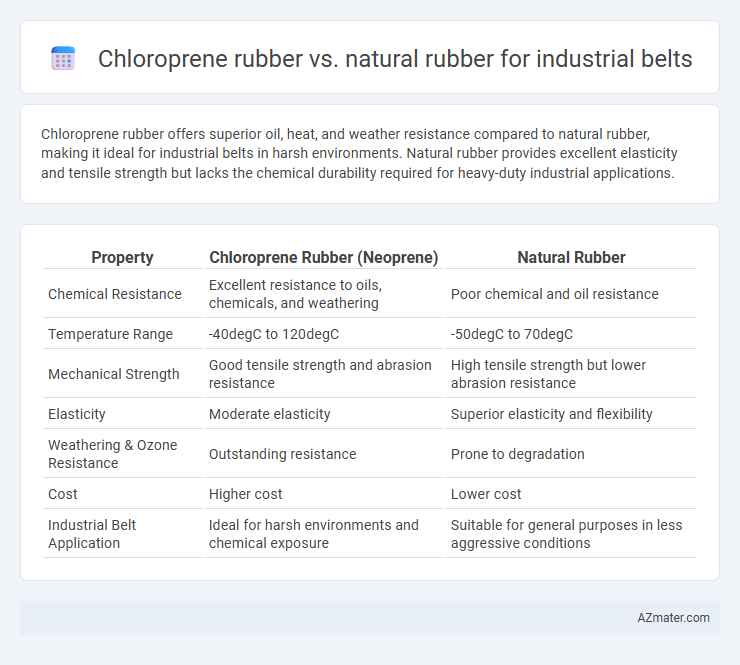Chloroprene rubber offers superior oil, heat, and weather resistance compared to natural rubber, making it ideal for industrial belts in harsh environments. Natural rubber provides excellent elasticity and tensile strength but lacks the chemical durability required for heavy-duty industrial applications.
Table of Comparison
| Property | Chloroprene Rubber (Neoprene) | Natural Rubber |
|---|---|---|
| Chemical Resistance | Excellent resistance to oils, chemicals, and weathering | Poor chemical and oil resistance |
| Temperature Range | -40degC to 120degC | -50degC to 70degC |
| Mechanical Strength | Good tensile strength and abrasion resistance | High tensile strength but lower abrasion resistance |
| Elasticity | Moderate elasticity | Superior elasticity and flexibility |
| Weathering & Ozone Resistance | Outstanding resistance | Prone to degradation |
| Cost | Higher cost | Lower cost |
| Industrial Belt Application | Ideal for harsh environments and chemical exposure | Suitable for general purposes in less aggressive conditions |
Introduction to Chloroprene and Natural Rubber
Chloroprene rubber, also known as neoprene, offers excellent resistance to oils, chemicals, and weathering, making it highly suitable for industrial belts subjected to harsh environments. Natural rubber provides superior elasticity, tensile strength, and abrasion resistance, ideal for dynamic applications requiring flexibility and durability. Comparing both materials highlights chloroprene's chemical stability versus natural rubber's mechanical resilience in industrial belt manufacturing.
Chemical Composition and Structure Comparison
Chloroprene rubber (CR) is a synthetic polymer primarily composed of polychloroprene units, featuring chlorine atoms that enhance chemical resistance and weathering properties, whereas natural rubber (NR) consists of cis-1,4-polyisoprene, derived from latex with high elasticity and tensile strength. The presence of chlorine in chloroprene rubber imparts superior oil, heat, and ozone resistance compared to the predominantly hydrocarbon-based natural rubber, which is more susceptible to oxidative degradation. Structurally, CR's partially crystalline polymer network provides improved dimensional stability for industrial belts under harsh chemical exposure, while NR's long-chain hydrocarbon configuration offers excellent flexibility and abrasion resistance but reduced chemical durability.
Mechanical Properties: Strength and Flexibility
Chloroprene rubber exhibits superior tensile strength and excellent resistance to abrasion, making it highly suitable for industrial belts subjected to heavy loads and harsh conditions. Natural rubber delivers exceptional flexibility and elongation properties, providing better shock absorption and elasticity under dynamic stress. The choice between chloroprene and natural rubber depends on the required balance of durability versus flexibility for specific industrial belt applications.
Temperature Resistance Capabilities
Chloroprene rubber exhibits superior temperature resistance capabilities compared to natural rubber, maintaining stability in industrial belt applications up to 120degC, whereas natural rubber typically degrades beyond 70degC. This enhanced thermal resilience of chloroprene rubber reduces the risk of belt deformation and loss of mechanical properties under continuous high-temperature conditions. Consequently, chloroprene rubber is preferred for industrial belts operating in environments with elevated thermal demands.
Chemical Resistance in Industrial Environments
Chloroprene rubber exhibits superior chemical resistance compared to natural rubber, making it ideal for industrial belts exposed to oils, fuels, and solvents. Its molecular structure provides enhanced durability against harsh chemicals and ozone, extending belt lifespan in aggressive environments. Natural rubber, while flexible and resilient, tends to degrade faster when exposed to industrial chemicals, reducing efficiency and increasing maintenance costs.
Abrasion and Wear Performance
Chloroprene rubber exhibits superior abrasion and wear resistance compared to natural rubber, making it ideal for industrial belt applications subjected to harsh conditions. Its molecular structure provides enhanced toughness and resilience against mechanical stress and chemical exposure. Natural rubber offers good flexibility but tends to degrade faster under abrasive environments, reducing belt longevity and increasing maintenance costs.
Cost Effectiveness and Availability
Chloroprene rubber offers superior chemical resistance and durability compared to natural rubber, making it more cost-effective for industrial belts with prolonged exposure to oils and harsh environments. Although Chloroprene tends to be more expensive upfront, its longer lifespan reduces replacement frequency and overall maintenance costs. Natural rubber, favored for its elasticity and lower initial price, remains widely available but may incur higher long-term expenses due to quicker wear and susceptibility to degradation.
Applications in Industrial Belt Manufacturing
Chloroprene rubber, known for its exceptional resistance to oil, heat, and weathering, is widely used in industrial belt manufacturing for applications requiring durability under harsh chemical and environmental conditions. Natural rubber, prized for its excellent elasticity and abrasion resistance, is preferred in industrial belts demanding high tensile strength and flexibility, especially in lighter load applications. The choice between chloroprene and natural rubber depends on the specific operational environment, with chloroprene often selected for belts exposed to oils and chemicals, while natural rubber suits general-purpose driving and conveyor belts.
Environmental Impact and Sustainability
Chloroprene rubber, known for its chemical resistance and durability, poses environmental concerns due to its synthetic production process involving chlorinated compounds that can release harmful emissions. Natural rubber, harvested from rubber trees, offers a renewable and biodegradable alternative with a lower carbon footprint, contributing positively to sustainability efforts in industrial belt manufacturing. However, natural rubber's environmental benefits depend on sustainable plantation practices to prevent deforestation and biodiversity loss.
Choosing the Right Rubber for Industrial Belts
Chloroprene rubber offers superior resistance to oil, chemicals, and weathering, making it ideal for industrial belts used in harsh environments. Natural rubber provides excellent tensile strength, elasticity, and abrasion resistance, suitable for applications requiring flexibility and durability under moderate conditions. Selecting the right rubber depends on operational demands: chloroprene is preferred for chemical exposure and temperature stability, while natural rubber excels in mechanical stress and wear resistance.

Infographic: Chloroprene rubber vs Natural rubber for Industrial belt
 azmater.com
azmater.com